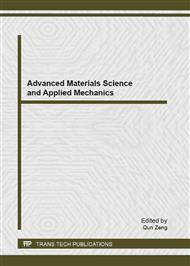[1]
H. L. Sun, C. Huang, Y. R. Wu et al., Dental Implants and Factors Influencing Their Failure: A Systematic Review. International J. of Oral & Maxillofacial Implants. 26(2011) 816-825.
Google Scholar
[2]
M. Esposito, L. Murray-Curtis, M. G. Grusovin et al., Interventions for replacing missing teeth: different types of dental implants. Cochrane Database of Systematic Reviews. 4(2007) CD003815.
DOI: 10.1002/14651858.cd003815.pub3
Google Scholar
[3]
E. E. Machtei, D. Mahler, O. Oettinger-Barak et al., Dental implants placed in previously failed sites: survival rate and factors affecting the outcome. Clinical Oral Implants Research. 19(2008) 259-264.
DOI: 10.1111/j.1600-0501.2007.01466.x
Google Scholar
[4]
J.P. Fiorellini, D. Buser, D.W. Paquette et al., A radiographic evaluation of bone healing around submerged and non-submerged dental implants in beagle dogs. Journal of Periodontology. 70(1999) 248-254.
DOI: 10.1902/jop.1999.70.3.248
Google Scholar
[5]
A. A. Balshe, D. A. Assad, S. E. Eckert et al., A Retrospective Study of the Survival of Smooth- and Rough-Surface Dental Implants. International Journal of Oral & Maxillofacial Impalnts. 24(2009) 1113-1118.
Google Scholar
[6]
S.D. Ferreira, L.A. Esper, M.C. Sbrana, I.W.J. Ribeiro, A.L.P.F. de Almeida, Survival of Dental Implants in the Cleft Area-A Retrospective Study. Cleft Palate-Craniofacial Journal. 47(2010) 586-590.
DOI: 10.1597/08-155
Google Scholar
[7]
D. Cardaropoli, L. Gaveglio, Supportive periodontal therapy and dental implants: an analysis of patients' compliance. Clinical Oral Implants Research. 23(2012) 1385-1388.
DOI: 10.1111/j.1600-0501.2011.02316.x
Google Scholar
[8]
P. Vaz, M.M. Gallas, A.C. Braga, J.C. Sampaio-Fernandes, A. Felino, P. Tavares, IL1 gene polymorphisms and unsuccessful dental implants. Clinical Oral Implants Research. 23(2012) 1404-1413.
DOI: 10.1111/j.1600-0501.2011.02322.x
Google Scholar
[9]
M. C. Goiato, D. M. dos Santos, A. A. Pesqueira et al, Hyperbaric oxygen therapy treatment for the fixation of implant prosthesis in oncology patients irradiated. Gerodontology. 29(2012) 308-311.
DOI: 10.1111/j.1741-2358.2012.00636.x
Google Scholar
[10]
L. Joska, J. Fojt, The effect of porosity on barrier properties of DLC layers for dental implants. Applied Surface Science. 262 (2012) 234-239.
DOI: 10.1016/j.apsusc.2012.07.013
Google Scholar


